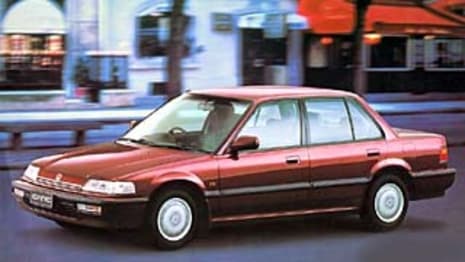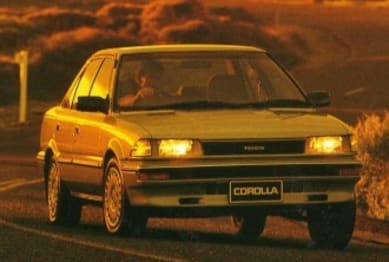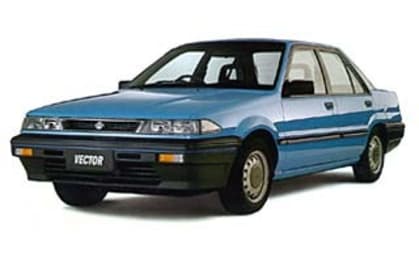
Used Honda Civic review: 1990-1995
- Honda Civic
- Honda Civic 1990
- Honda Civic 1991
- Honda Civic 1992
- Honda Civic 1993
- Honda Civic 1994
- Honda Civic 1995
- Honda Civic Reviews
- Honda Reviews
- Honda Hatchback Range
- Honda Sedan Range
- Hatchback
- Sedan
- Honda
- Used Car Reviews
- Small Cars

Big cars were still going gangbusters when the fifth-generation Honda Civic hit the road in the early 1990s, with the seismic shift in the market that saw Australians abandon their big-car behemoths in droves to seek smaller, more efficient cars still years away, let alone the equally sizeable shift to SUVs that would soon follow.
Small cars were still mostly being bought by the young, the impoverished, or the aged. For them, a small car was as good as they could afford. And that’s because the cars were mostly cheap and cheerful, and sparsely equipped with few of the standard features they would have in years to come.
But while the Civic fell into that category, it was generally perceived as better than the rest.
By the beginning of the 1990s, rival carmakers had caught up and the Civic found itself competing in a very crowded and competitive marketplace. It was regarded as well-built and reliable, but its performance was lacklustre and it was no longer as economical - a key quality small-car buyers were seeking.
What lifted the Civic out of the doldrums was the arrival of the VTEC engine in the middle of its model life. With its clever variable valve timing and lift system, Honda could extract amazing performance from a small engine.
With the VTEC engine under its bonnet, the Civic, particularly the performance-oriented VTi, came to life; in the blink of an engineer's eye, it was transformed.
Models
While heavily revised, there was little to make the fifth-generation, front-wheel-drive Civic stand out when it was launched in 1991. Its styling was wishy-washy and its performance was breathless, but it handled well and was well built.
The fifth-gen Civic range opened with the Breeze, a bright and bubbly three-door hatch with a modest 1.3-litre, four-cylinder engine. It had a five-speed manual gearbox, there was no automatic transmission option, and power steering was standard.

The mid-range GL came in three-door hatch and four-door sedan forms. It had a 1.5-litre, four-cylinder engine, and the choice of a five-speed manual gearbox or four-speed automatic transmission.
Standard equipment consisted of power windows and mirrors, central locking, a tachometer and a radio/cassette sound system.
Top of the range at launch was the Si, which also came as a three-door hatch and a four-door sedan. Power was from a 1.6-litre, four-cylinder engine, and it too had a choice of five-speed manual gearbox or four-speed auto transmission.

The list of standard features was short, consisting of central locking, power windows and mirrors, and power steering.
Stung by criticism of the fifth-gen Civic’s performance and economy, Honda introduced some much-needed improvements in 1993. It began with the release of the VEi sedan, which featured a 1.5-litre, four-cylinder VTEC engine that was configured for economy and had a five-speed manual gearbox.
Standard features of the VEi included an airbag for the driver, power steering, central locking, power windows and mirrors, a tachometer, and cloth trim. But the upgrade rolled on a few months later, in September 1993, with a raft of revisions, particularly to the engines offered.
The Breeze especially got a new lease on life, with a 1.5-litre, four-cylinder engine and more power and torque. At the same time the GLi, which had a fuel-injected 1.5-litre, four-cylinder engine that boosted its performance, replaced the GL, and a new performance model, the VTi, was added to the range.

If the VEi was all about economy, the VTi was a breath of fresh air with the emphasis on performance. Available as a sedan or hatch it had a 1.6-litre double overhead camshaft, four-cylinder VTEC engine and the option of a five-speed manual gearbox or four-speed automatic transmission.
Standard equipment on the VTi included central locking, power windows and mirrors, and a power sunroof.
Driver’s side airbags became standard across the range in August 1994. Air conditioning was available as an option, but it wasn’t climate control.
This Civic came long before the advent of features such as Bluetooth that allowed you to synch an iPhone or Android device; there was no sat nav system or touch screen. None of the things that make parking easy today were available in the early 1990s, either, hence the fifth-gen Civic had no reversing camera or parking sensors, and no clever park-assist system.
Cabin
Small cars of the period had few creature comforts, but the Honda had seats that were quite comfortable, and there was reasonable room for the five occupants given the modest size of the car.
The dash was simple and well laid out, and the controls fell easily to hand and were easy to use. Cupholders were fitted in the dash.
Engine
A 1.3-litre single overhead camshaft powered the Breeze, a carburettor-fed, four-cylinder petrol engine that struggled to produce 55kW (a miserable 73 horsepower) and 102Nm. The performance wasn’t great, but the economy was acceptable.
It wasn’t much better with the GL, which had a 1.5-litre single overhead cam four-cylinder engine with twin carburettors. Although it produced more power and torque - 74kW and 133Nm respectively - it was a disappointing performer, and thirsty to boot.
The Breeze got a new lease on life in 1993 with a 1.5-litre, four-cylinder engine, which now had single-point fuel injection and produced 67kW and 119Nm.
To deliver better fuel economy, Honda launched the VEi in 1993 with a 1.5-litre single overhead camshaft four-cylinder engine with single-point fuel injection. Its performance peaks were 66kW and 129Nm.
For performance Honda unveiled the VTi, which boasted a 1.6-litre double-overhead camshaft engine with multi-point fuel injection. At its best it boasted 96kW and 145Nm, and had plenty of low-down grunt as well as impressive top-end zip.
That said, you could expect little in the way of towing capacity, no matter which model you opted for.

Driving
Like its predecessors the fifth-gen Civic was a delight to drive, it handled and steered well, and with disc brakes it stopped well, too.
The performance of the early models was slammed for being lacklustre, but later models were much better with the updated engines improving matters immeasurably. Road noise across all models was on-par for the times.
The VTi, in particular, was a car aimed at the driver who enjoyed thrill of motoring a rapid little car. It revved hard and rewarded those who explored its limits.
Safety
There just wasn’t same emphasis on safety as there is today, so don’t go expecting too much from your second-hand Civic. It had none of the active safety features we now expect; there was no ABS braking, or any of the related systems, such as stability control.
Passive safety features were similarly lacking. There were no airbags at the launch of the fifth-gen Civic; it wasn’t until 1994 that a driver’s airbag was introduced across the range.
Lap/sash seat belts were fitted, but there were no ISOFIX mounting points, so fitting a baby car seat is problematic.
Any common issues?
This Civic was rated highly when new, particularly after the revised engines were introduced. But that was 20 (or more) years ago, and it’s now fast approaching the end of the road.
Buy on condition, odometer and service record. Only consider a car that ticks all those boxes.
The VTi is highly regarded and easily the pick of the bunch. It has got good performance while still delivering impressive fuel consumption.
The reliability of the Civic is generally good; engines, gearboxes, drivelines and diffs rarely give any trouble. Though rear wheel bearings can be a source of trouble.

The problems are mostly related to ancillaries, like air-conditioning compressors, which are a known source of issues.
There are no real problems with the Civic body; they were well built in the first instance and stand up well in service. Check for service record, and evidence of regular maintenance. And check that the spare tyre is unused, or is at least in working order should you have a problem.
This Civic was launched well before capped-price servicing was a thing, but service costs are not excessive.
Belts were used to drive the camshafts and these need to be changed every 100,000km or so. When checking the service record make sure the belts have been changed as Honda recommends. And with any warranty now the most distant of memories, any issues will be your issues.
MORE: If anything crops up, you’ll probably find it on our Honda Civic problems.
Owners view
Kristen Jones: I owned a 1993 Breeze for four years. It was very cheap to run, easy to drive, and easy to park. I had no problems with it and would happily recommend it.
Debbie Williamson: I bought a 1993 GL new. I found it reliable, comfortable, economical, attractive, and roomy. It was easy to drive and nothing went wrong with it.
Jim Liaskos: I owned a 1994 GLi manual for 10 years and did more than 250,000 km in it. In that time it handled well and was very economical. Apart from normal service items, I only replaced the front wheel bearings, the clutch master cylinder, noisy gearbox bearings, thermostat, and the brake master cylinder.
Verdict
The Civic was struggling before the revised engine range arrived in 1993, which significantly improved its performance and economy. If you're shopping for a Civic, it would pay to shop post-1993 models.
Pricing
| Year | Price From | Price To |
|---|---|---|
| 1995 | $2,420 | $6,490 |
| 1994 | $2,420 | $5,830 |
| 1993 | $2,420 | $5,830 |
| 1992 | $2,420 | $4,950 |
| 1991 | $2,420 | $4,950 |
| 1990 | $2,750 | $4,950 |
Pricing guides
Range and Specs
| Vehicle | Specs | Price* | |
|---|---|---|---|
| GL | 1.5L, ULP, 4 SP AUTO | $2,970 – 4,620 | 1990 Honda Civic 1990 GL Pricing and Specs |
| GL | 1.5L, ULP, 5 SP MAN | $2,970 – 4,620 | 1990 Honda Civic 1990 GL Pricing and Specs |
Other cars to consider
$2,640
Lowest price, based on third party pricing data











